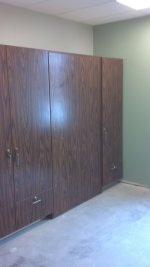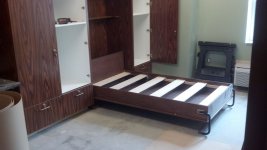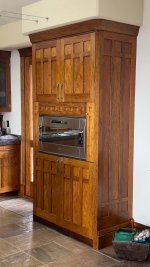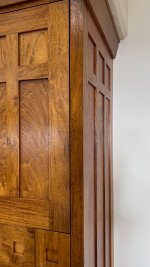smorgasbord
Member
We've decided that our spare room should have a Queen size Murphy bed, which I get to build.
There are a few companies selling mechanisms:
1) The most popular seems to be the Create-A-Bed. It's sold on Amazon and at Rockler. The one I'd get is the new Adjustable version, in which the bottom piston attachment point can be moved in and out to change the leverage. Here's a link:https://createabed.com/products/adjustable-deluxe-bed-mechanism
2) This Canadian company, Murphy Wall Beds, sells both mechanisms and complete beds. They have two versions of the mechanisms, both of which have high weight limits and 25 year or lifetime warranties. The more expensive one is aluminum, which is lighter so you have more freedom on what you use for mattress and face panel. They both use springs instead of air/gas pistons, and you adjust them by how many springs you put on, and where you put them on. These kits are twice the price, but they include metal bed framing that you bolt together and then bolt your "face panel" onto. Here's a link:https://www.murphybeds.com/shophardware
3) Murphy Bed Depot, located in Florida, sells a kit that is similar to the cheaper of the two Murphy Wall Beds kit, but is even cheaper, just about $100 more than the Create-A-Bed kit. Here's a link:https://murphybeddepot.com/products/panel-bed-frame-free-shipping-to-cont-48-u-s-states
One thing that turned me off on the Create-A-Bed kit is that they insist you build the mattress inner frame out of plywood (¾" by 6" wide), claiming that even hardwoods aren't strong enough. Which means the plywood edge is visible right on the top, and there's a curve at the top front, so you're edge banding, which I personally dislike. The other two brands have metal inner mattress framing, so they handle the weight without problem.
Create-A-Bed seems to be the most popular, judging by YouTube videos and in talking with Customer Support at Rockler (who also sells an I-Semble brand kit that I'm not particularly interested in).
Murphy Wall Beds claims that springs hold their tension better and for longer than pistons. I also like that the springs are a more compact mechanism - with the pistons you always see the pistons above the mattress on the sides, but the spring mechanism is hidden by the mattress at all times, unless you look between the mattress and the sides.
Anyone have any comments, experience, what to look for thoughts on these?
And also a secondary thought is that the cabinet one needs to build for these things, if not actually a built-in, probably should be constructed as a flat-panel ready-to-assemble unit so that we could take it apart to move it to another room/house. The Create-A-Bed design simply screws things into end grain, but other designs leverage pocket screws from the back/top where they're not normally visible. Since I have a domino, what are the thoughts on using the DF500 knock-down hardware for these nominal ¾" panels? I'm sure there are other knock-down hardware choices as well.
Thanks in Advance for any thoughts, hints, etc.
There are a few companies selling mechanisms:
1) The most popular seems to be the Create-A-Bed. It's sold on Amazon and at Rockler. The one I'd get is the new Adjustable version, in which the bottom piston attachment point can be moved in and out to change the leverage. Here's a link:https://createabed.com/products/adjustable-deluxe-bed-mechanism
2) This Canadian company, Murphy Wall Beds, sells both mechanisms and complete beds. They have two versions of the mechanisms, both of which have high weight limits and 25 year or lifetime warranties. The more expensive one is aluminum, which is lighter so you have more freedom on what you use for mattress and face panel. They both use springs instead of air/gas pistons, and you adjust them by how many springs you put on, and where you put them on. These kits are twice the price, but they include metal bed framing that you bolt together and then bolt your "face panel" onto. Here's a link:https://www.murphybeds.com/shophardware
3) Murphy Bed Depot, located in Florida, sells a kit that is similar to the cheaper of the two Murphy Wall Beds kit, but is even cheaper, just about $100 more than the Create-A-Bed kit. Here's a link:https://murphybeddepot.com/products/panel-bed-frame-free-shipping-to-cont-48-u-s-states
One thing that turned me off on the Create-A-Bed kit is that they insist you build the mattress inner frame out of plywood (¾" by 6" wide), claiming that even hardwoods aren't strong enough. Which means the plywood edge is visible right on the top, and there's a curve at the top front, so you're edge banding, which I personally dislike. The other two brands have metal inner mattress framing, so they handle the weight without problem.
Create-A-Bed seems to be the most popular, judging by YouTube videos and in talking with Customer Support at Rockler (who also sells an I-Semble brand kit that I'm not particularly interested in).
Murphy Wall Beds claims that springs hold their tension better and for longer than pistons. I also like that the springs are a more compact mechanism - with the pistons you always see the pistons above the mattress on the sides, but the spring mechanism is hidden by the mattress at all times, unless you look between the mattress and the sides.
Anyone have any comments, experience, what to look for thoughts on these?
And also a secondary thought is that the cabinet one needs to build for these things, if not actually a built-in, probably should be constructed as a flat-panel ready-to-assemble unit so that we could take it apart to move it to another room/house. The Create-A-Bed design simply screws things into end grain, but other designs leverage pocket screws from the back/top where they're not normally visible. Since I have a domino, what are the thoughts on using the DF500 knock-down hardware for these nominal ¾" panels? I'm sure there are other knock-down hardware choices as well.
Thanks in Advance for any thoughts, hints, etc.







